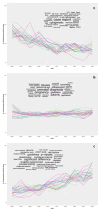Trends in Fetal Medicine: A 10-Year Bibliometric Analysis of Prenatal Diagnosis
- PMID: 29295220
- PMCID: PMC5884683
Trends in Fetal Medicine: A 10-Year Bibliometric Analysis of Prenatal Diagnosis
Abstract
The objective is to automatically identify trends in Fetal Medicine over the past 10 years through a bibliometric analysis of articles published in Prenatal Diagnosis, using text mining techniques. We processed 2,423 full-text articles published in Prenatal Diagnosis between 2006 and 2015. We extracted salient terms, calculated their frequencies over time, and established evolution profiles for terms, from which we derived falling, stable, and rising trends. We identified 618 terms with a falling trend, 2,142 stable terms, and 839 terms with a rising trend. Terms with increasing frequencies include those related to statistics and medical study design. The most recent of these terms reflect the new opportunities of next-generation sequencing. Many terms related to cytogenetics exhibit a falling trend. A bibliometric analysis based on text mining effectively supports identification of trends over time. This scalable approach is complementary to analyses based on metadata or expert opinion.
Keywords: Bibliometrics; Prenatal Diagnosis.
Figures



Similar articles
-
Trends in prenatal diagnosis: An analysis of 40 years of Medical Subject Heading (MeSH) terms in publications.Prenat Diagn. 2020 Dec;40(13):1636-1640. doi: 10.1002/pd.5871. Prenat Diagn. 2020. PMID: 33225453 Free PMC article.
-
Using Data Mining, Text Mining, and Bibliometric Techniques to the Research Trends and Gaps in the Field of Language and Linguistics.J Psycholinguist Res. 2023 Apr;52(2):607-630. doi: 10.1007/s10936-022-09911-6. Epub 2022 Sep 20. J Psycholinguist Res. 2023. PMID: 36125692
-
Research Hotspots and Trends in the Diagnosis of Chorioamnionitis: Based on Bibliometric Analysis from 2010 to 2022.Am J Perinatol. 2024 May;41(S 01):e2159-e2167. doi: 10.1055/s-0043-1770366. Epub 2023 Jun 26. Am J Perinatol. 2024. PMID: 37364595
-
AI in Surgery: Navigating Trends and Managerial Implications Through Bibliometric and Text Mining Odyssey.Surg Innov. 2024 Dec;31(6):630-645. doi: 10.1177/15533506241289481. Epub 2024 Oct 4. Surg Innov. 2024. PMID: 39365951 Review.
-
Longitudinal trends in global obesity research and collaboration: a review using bibliometric metadata.Obes Rev. 2016 Apr;17(4):377-85. doi: 10.1111/obr.12372. Epub 2016 Feb 11. Obes Rev. 2016. PMID: 26864566 Review.
Cited by
-
Trends in research related to fetal therapy from 2012 to 2022: a bibliometric analysis.Front Pediatr. 2024 Jan 4;11:1288660. doi: 10.3389/fped.2023.1288660. eCollection 2023. Front Pediatr. 2024. PMID: 38293659 Free PMC article.
References
-
- Bianchi DW, Van Mieghem T, Shaffer LG, et al. In case you missed it: the Prenatal Diagnosis section editors bring you the most significant advances of 2013. Prenat Diagn. 2014;34:1–5. - PubMed
-
- Bolli R. The 10 Most Read Articles Published in Circulation Research in 2015. Circ Res. 2016 - PubMed
-
- Cuckle HS, Wald NJ, Lindenbaum RH. Maternal serum alpha- fetoprotein measurement: a screening test for Down syndrome. Lancet. 1984;1:926–929. - PubMed
MeSH terms
Grants and funding
LinkOut - more resources
Full Text Sources
Miscellaneous

